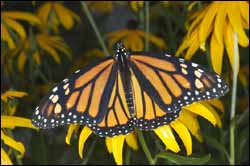How Butterflies Fly Thousands Of Miles Without Getting Lost Revealed By Researchers

A typical monarch butterfly. photo courtesy of Scott Camazine (www.scottcamazine.com)
While “navigation” systems in automobiles are a fairly new (and still costly) innovation, monarch butterflies have managed for millennia to navigate their way for a distance of some 3000 miles (4800 kilometers) each fall from Canada to Mexico (and vice-versa in the spring) without losing their way.
The phenomenon of long-range bird migration is a well-known one, but not in the insect world. Also, among birds their migration route is a round-trip one, which they make more than once in their lifetimes, while for the monarch it is strictly a one-way trip for each butterfly. How do these creatures do it?
The mystery of the mechanisms involved in this remarkable phenomenon has been resolved by a team of scientists who did this by exploring the infinitesimal butterfly brain and eye tissues to uncover new insights into the biological machinery that directs this delicate creature on its lengthy flight path.
The research team, led by Prof. Steven Reppert of the University of Massachusetts Medical School, included Dr. Oren Froy, now of the Faculty of Agricultural, Food and Environmental Quality Sciences of the Hebrew University of Jerusalem. Others involved were from the Czech Academy of Sciences and the University of California, Irvine. Their latest findings were published in a recent issue of Neuron magazine, constituting a continuation of their earlier work, published in the journal Science.
While light in general is essential to the functioning of the “biological clock” in the butterfly brain – governing its metabolic cycles, including its “signal” to migrate — the researchers discovered that it is specifically the ultraviolet band of light that is crucial to the creature’s orientation. The butterflies have special photoreceptors for ultraviolet (UV) light in their eyes which provide them with their sense of direction.
They proved that this ultraviolet “navigation” is crucial by placing butterflies in a “flight” simulator. When a UV light filter was used in the simulator, the butterflies lost their orientation
Further probing revealed a key wiring connection between the light-detecting navigation sensors in the butterfly’s eye and its brain clock Thus, it was shown that input from two interconnected systems – UV light detection in the eye and the biological clock in the brain — together guide the butterflies “straight and true” to their destination at the appointed times in their two-month migration over thousands of miles/kilometers.
Media Contact
More Information:
http://media.huji.ac.ilAll latest news from the category: Life Sciences and Chemistry
Articles and reports from the Life Sciences and chemistry area deal with applied and basic research into modern biology, chemistry and human medicine.
Valuable information can be found on a range of life sciences fields including bacteriology, biochemistry, bionics, bioinformatics, biophysics, biotechnology, genetics, geobotany, human biology, marine biology, microbiology, molecular biology, cellular biology, zoology, bioinorganic chemistry, microchemistry and environmental chemistry.
Newest articles

Properties of new materials for microchips
… can now be measured well. Reseachers of Delft University of Technology demonstrated measuring performance properties of ultrathin silicon membranes. Making ever smaller and more powerful chips requires new ultrathin…

Floating solar’s potential
… to support sustainable development by addressing climate, water, and energy goals holistically. A new study published this week in Nature Energy raises the potential for floating solar photovoltaics (FPV)…

Skyrmions move at record speeds
… a step towards the computing of the future. An international research team led by scientists from the CNRS1 has discovered that the magnetic nanobubbles2 known as skyrmions can be…





















